Sep 2nd 2012
How to Choose a Fireplace Grate
This Article has been approved by our on staff NFI Certified Specialists & Master Hearth Professionals

With Northline Express you can save up to 65% Off Fireplace Grates!
Who would have thought a fireplace grate could have so many options? With our large selection believe us when we tell you that anyone could get overwhelmed if you didn't know exactly what you were looking for. We are going to try and answer any questions you may have, as well as inform you about the different types of fireplace grates, why you should use a grate, and how to get the most out of your fireplace grate.
There are three main types of fireplace grates; steel bar used for wood, cast iron generally used for wood or coal, and grate heaters for wood which produce heat back into the home. Coal cannot be used on the steel bar grates simply because the bars are spread too far apart, and the coal would fall through. Wood on the other hand can be burned on a steel grate or a cast iron grate, however they tend to hold the embers on the grate blocking the air from reaching the wood. Cast iron grates tend to last longer than the average steel bar grate with the exception of very heavy steel bar grates. The best steel bar grate available is a Lifetime Fireplace Grate. Lifetime Fireplace Grates are guaranteed by the factory to last a lifetime and will be the last grate that you will ever buy. Grate heaters are tubular (hollow) grates that once hot will blow warm or hot air back into the home. While not quite as efficient as a fireplace insert, they are about one forth the price and do a great job of pumping heat into your home.
See our selection of over 90 fireplace grates styles! Choose from a variety of steel fireplace grates, cast iron fireplace grates, fireplace grate heaters, and lifetime fireplace grates. A grate is sure to make lighting fires in your fireplace a breeze and keep your fireplace operating with efficiency throughout burning sessions.
So, you're probably left asking which fireplace grate is right for me?
Which actually opens up a couple other things to ask yourself:
First, how often do you have fires?
Rare Burner - If your grate will be used for rare occasions only, like holidays, birthdays, and special celebrations, then a lighter duty grate will do just fine.
Frequent Burner - If you are burning once a month or more, than a middle to high grade grate should be considered.
Daily Burner - If this is you then you probably already know that you need the thickest, heaviest grate you can afford.
Also consider the type of wood being burnt. Hardwoods like, Maple, Oak, Beachwood, etc. burn hotter than softer woods, adding stress to your grate and potentially shortening its life.
Are you looking for an indoor fireplace grate or an outdoor fireplace grate?
The environment in which your grate will be used is also a factor, elements such as humidity, rain, or salt can cause the grate material to corrode weakening it over time. Therefore, outdoor grates will need to be a little more heavy-duty or made of more outdoor friendly materials like a stainless steel.
What are firegrates made of?
Fireplace greats are typically made from Steel or Cast Iron.
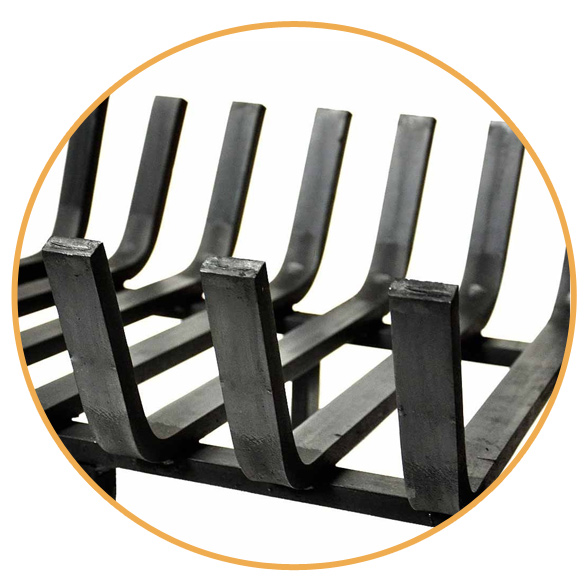
Lifetime Fireplace Grates
Northline Express customers choose Lifetime Fireplace Grates because they are the last fireplace grate that they would ever have to buy. With a factory guarantee, lifetime fireplace grates will last year after year. Made from durable 1-inch-wide steel, these grates can withstand daily burning for an entire lifetime. These fireplace grates come in a variety of sizes to ensure you find the one that will fit your fireplace best. They have legs that measure 3 1/4" to allow proper airflow for a even burn every time. Choosing a lifetime fireplace grate can save you hundreds of dollars and every lifetime grate ships for free!
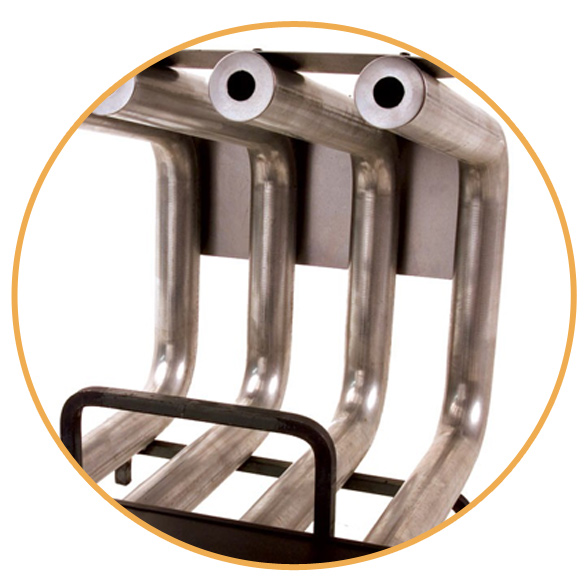
Fireplace Grate Heaters
Fireplace Grate heaters are another alternative that we highly recommend. While there is a higher price tag, a grate heater can pay for itself quickly from the heat it produces back into the room. There are various types of these heat exchangers, but the basic principle is the same. Hollow tubing gets hot from the fire and a fan blows heat through the hollow tubes into the room. Some are thermostatically controlled so the fan turns on and off automatically once the tubing gets hot. Expect to Get 10,000 to 40,000 BTUs of heat back into your home from these units which is enough to heat a large room and other parts of the home.
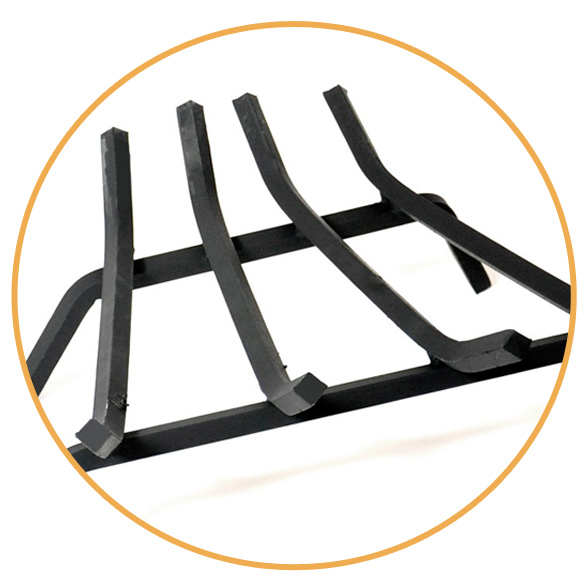
Steel Bar Grates
Watch for poor welds where the top bars meet the legs. The welds should be on the diagonals not on the flats. These welds are going to be the most likely places for the grate to break.Thin steel bars result in short life span, generally 1/2" bars are used and for even the rare user they may not last long if you are burning hardwoods. I always suggest upgrading to at least the 5/8" grate. All grates are going to rust due to heat and moisture. A good chimney cap may help to keep moisture out of the firebox. Our grates are powder coated for initial protection but after several burns this will wear down as well. Last but not least the number of bars in relation to the width are important. One less bar means less heat distribution meaning more stress on the welds.
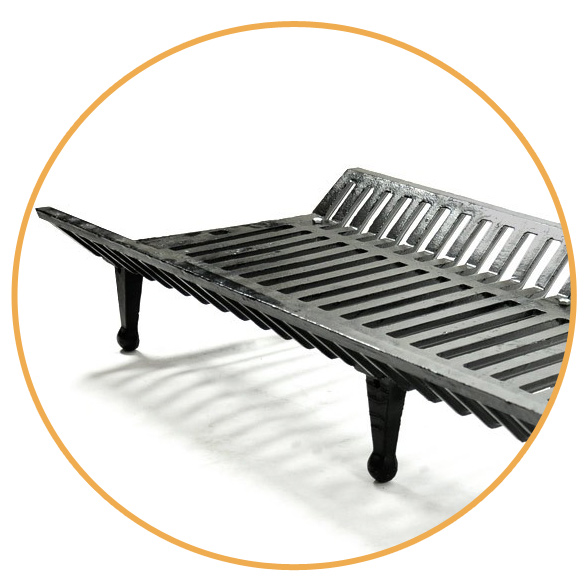
Cast Iron Grates
Weight, weight, weight, it's all about the weight. Weigh the grates at you local hardware store and compare it to the weight of our grates on line. The heavier the better. As for design, it is really personal preference. No one style is necessarily better than the other. Be aware some cast iron grates are now being made to burn wood so watch for large gaps in the bottom if you are using it to burn coal.
What are Differences Between Steel Bar Grates and Cast Iron Grates?
Steel Bar Grates
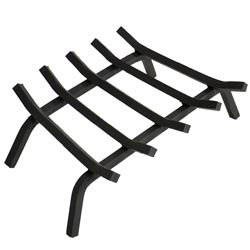
About
Steel bar grates are generally separated by the thickness of the bars used for constructing the grate. The general rule of thumb is the thicker the bars the longer it will last. The main things you want to look at are how often you plan on using the fireplace and what type of wood you will be burning.
Rare Burner
If this will be used on a rare occasion only, holidays, birthdays, and special occasions then a lighter duty grate will do just fine.
Frequent Burner
If you are burning once a month or more then a middle to high grade grate should be considered. Also consider the type of wood, hardwoods like, Maple, Oak, Beachwood, etc. burn hotter than softer woods adding stress to your grate. Thicker steel will last longer.
Daily Burner
If this is you then you probably already know that you need the thickest, heaviest grate you can afford. We now offer a Lifetime Grate for those who burn all the time.
Cast Iron Grates
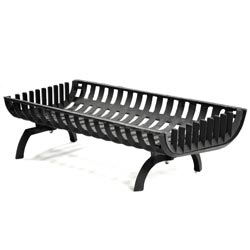
About
Now let's take a look at the cast iron grate. Cast iron grates have small gaps on the bottom to allow your coal or wood chunks to stay on the grate longer burning more completely. The bottom line with cast iron is weight. The heavier the grate the stronger. Again, you can determine what is right for you by the amount you plan on burning.
Rare Burner
If this will be used on a rare occasion only, holidays, birthdays, and special occasions then a lighter duty grate will do just fine.
Frequent Burner
If you are burning once a month or more then a middle to high grade grate should be considered.
Daily Burner
If this is you then you probably already know that you need the thickest, heaviest grate you can afford.
Make Sure You Get the Best Fireplace Grate
Watch for poor welds where the top bars meet the legs. The welds should be on the diagonals not on the flat, as these welds create weak spots and are going to be the most likely places for the grate to break. Thin steel bars result in short life span, generally 1/2" bars are used and for even the rare user and they may not last long if you are burning hardwoods. We always suggest upgrading to at least the 5/8" grate. All grates are going to rust due to heat and moisture. A good chimney cap may help to keep moisture out of the firebox. Our grates are powder coated for initial protection but after several burns this will wear down as well. The number of bars in relation to the width are important. One less bar means less heat distribution meaning more stress on the welds.
Heavy Duty Fireplace Woodstove Grates
Weight, weight, weight, it's all about the weight. Weigh the grates at your local hardware store and compare it to the weight of our grates online. The heavier the better. As for design, it is really personal preference. No one style is necessarily better than the other. Be aware some cast iron grates are now being made to burn wood so watch for large gaps in the bottom if you are using it to burn coal.
What size fireplace grate do I need?
This can depend on a couple things, most importantly the dimensions of your firebox, which we'll will go over next, but don't forget about other details like the size of your logs, (or fuel like coal) smaller pieces might require the size of your bars to be larger or closer together.
How to measure for a fireplace grate?
Measure both the front width and rear width at the floor of your firebox. It's important to get both the front width and rear widths because more often than not the dimension will taper towards the back. You want to make sure that your new grate will fit the front width as well as the smaller rear measurement. Then measure the depth from the front opening to the rear wall of the firebox. Now to get the right grate size, subtract 6" from both the shortest width and the depth dimensions to give you the ideal 3" of space around your grate.
6 Reasons Why you need a Fireplace Grate for your Fireplace
Better quality burn
The wood is lifted off of the floor allowing air to be pulled in from underneath the wood, your fire will be supercharged with air making it hotter and more efficient.
More complete burn
Burned pieces of wood fall to the fireplace floor through the spaces in the grate, creating a bed of super-hot coals. This allows the wood above to be burned from the bottom up, so you don't need to adjust and move the wood once placed on the grate.
Protection of your fireplace floor
The grate keeps the real heat up off the firebox floor protecting your concrete from the extreme heat of the fire. This will add life to your fireplace. The grate keeps the real heat up off the floor protecting your concrete from the extreme heat of the fire. This will add life to your fireplace.
Better drafting
When you lift the fire off of the floor you do two things, lift the fire closer to the chimney and allow air to move under the fire. By doing this you not only supercharge your fire, but you also help it draft smoke and fumes out the chimney instead of into your home. Sometimes a smoking fireplace can be cured by the use of a grate.
Less work
Most fireplace grates have a front and back that curl up. This helps to cradle your firewood to keep it in one location and also helps to continuously force the wood to the middle of the grate. Instead of having to move the wood around all the time you simply add more when needed. This can help reduce hot embers from popping out and burning your floor as well.
Easier to light
Using a grate allows air to get under the wood making the fire much easier to start
Where to Buy Fireplace Grate? - Grates for Sale
Shopping fireplace grates online is easy right here with us at Northline Express, simply click here to shop our website! Or give us a call at 1-866-667-8454 and speak to one of our friendly customer service representatives for one-on-one help.

